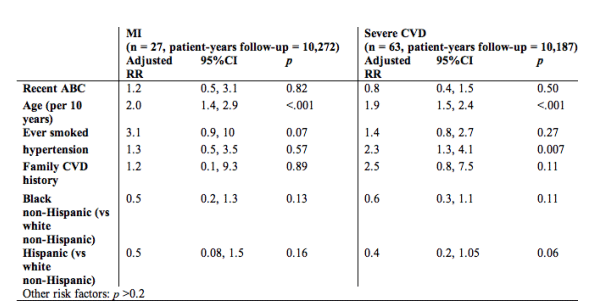 |
 |
 |
| |
No Association of Abacavir Use with Risk of Myocardial Infarction or Severe Cardiovascular Disease Events: Results from ACTG A5001
|
| |
| |
Reported by Jules Levin, CROI 2009 Feb 8-12 2009, Montreal, Canada
Constance Benson*1, H Ribaudo2, E Zheng2, S Koletar3, M Smurzynski2, R Bosch2, B Bastow4, A Collier5, J Schouten5, and the ACTG A5001/ALLRT Protocol Team
1Univ of California, San Diego Sch of Med, US; 2Harvard Sch of Publ Hlth, Boston, MA, US; 3Ohio State Univ Coll of Med, Columbus, US; 4Social & Sci Systems Inc, Silver Spring, MD, US; and 5Univ of Washington Sch of Med, Seattle, US
ABSTRACT
Background: The D:A:D study reported that the recent use of abacavir (ABC) was associated with increased risk of myocardial infarction (MI); the SMART study noted a similar association with severe cardiovascular disease (CVD). We evaluated the association between ABC use and the risk of MI and severe CVD after starting ART in ART-naïve HIV-infected patients.
Methods: Data were analyzed from 3205 patients randomized to their first ART regimen in one of 5 ACTG studies; extended follow-up was available for 2164 patients through the ALLRT long-term protocol. Follow-up was censored at the first of off-study, death, initiation of non-randomized ABC or 6 months after the last visit or discontinuation of randomized ART (not including within class substitutions not involving ABC). Relative risk (RR) for randomized ABC exposure (crude and adjusted) for gender, race/ethnicity, and baseline age, HIV RNA, and CD4, didanosine (ddI) use, and classic risk factors for CVD, e.g., smoking, hypertension, dyslipidemia, CVD, and family history of CVD, were estimated with Poisson regression. With follow-up censored as described randomization to ABC is interpreted as recent exposure. MI were included if assessed as definite or probable by 2 independent reviewers.
Results: For 3205 patients, median CD4 was 205 cells/μL, HIV RNA 5 log10, age 37, 40% white non-Hispanic, 37% black non-Hispanic, 20% Hispanic; 18% women; 781 patients were randomized to ABC. We identified 63 severe CVD events, including 27 MI. Significant associations between either MI or severe CVD and recent ABC exposure were not detected in unadjusted (RR = 1.02, 95%CI 0.4 to 2.5, p = 0.96, RR = 0.8, 95%CI 0.5 to 1.6, p = 0.58, respectively) and adjusted analyses (table). Significant increases in the risk of events were detected for some classic CVD risk factors, i.e. older age and hypertension.

Conclusions: In contrast to D:A:D and SMART, we did not find a significant association between recent ABC use and MI or severe CVD risk for ART-naïve patients randomized to an initial ABC regimen. Our results suggest the association with recent ABC use in other studies may be a marker for other factors not discerned in their analyses.
|
| |
|
 |
 |
|
|